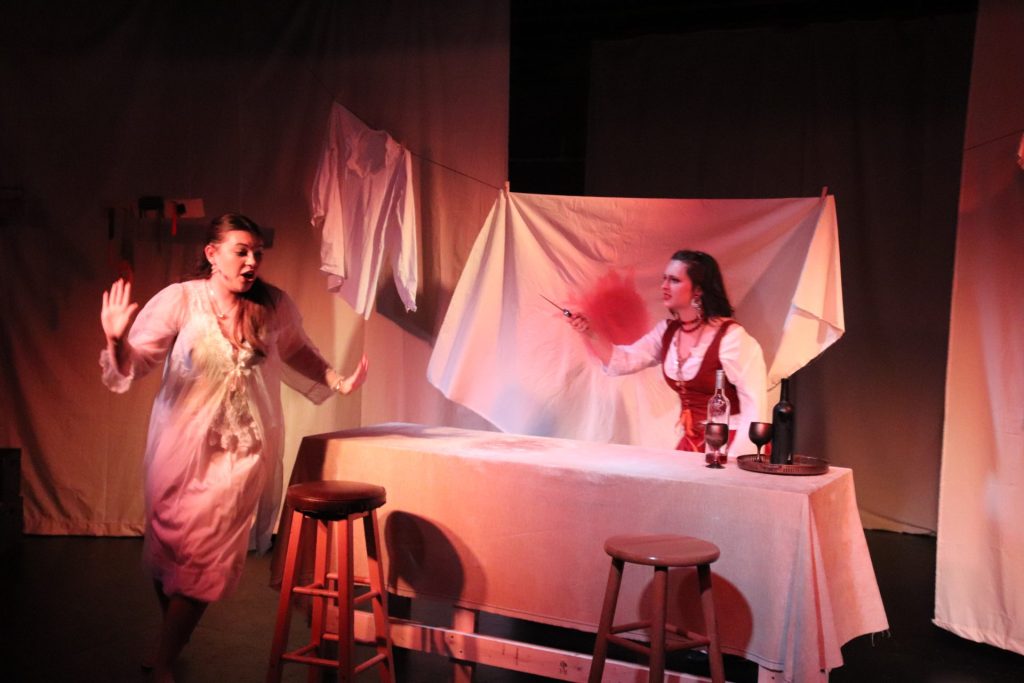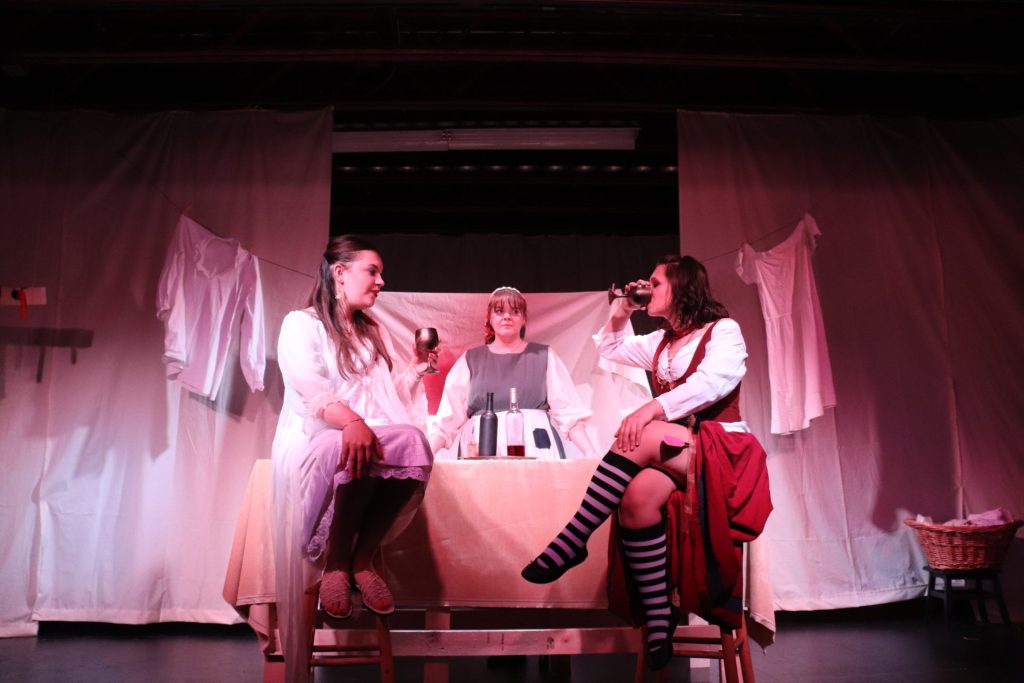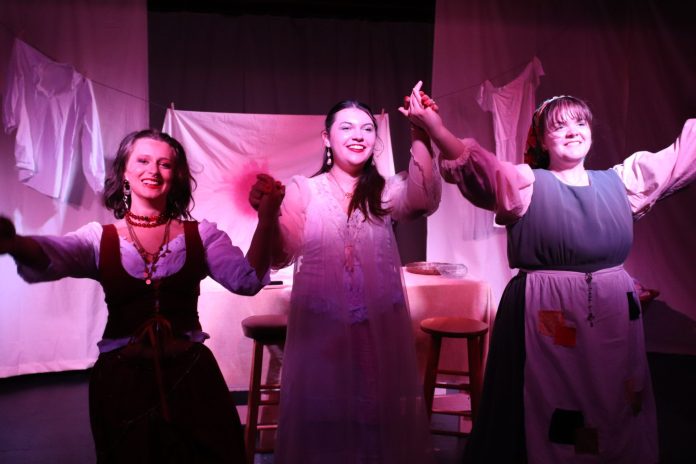For three nights in the Coleman Recital Hall, Transy Theater once again wowed the Transy community with a comically tragic take on a previous classic. Coming off a raucous run of Kate Hammil’s theatrical adaptation of Pride and Prejudice, Transy Theater once again showed a revisionist perspective on a well-known story, this time the iconic Shakespearean tragedy Othello. Paula Vogel’s Desdemona: A Play About a Handkerchief, first performed in 1993, flips the perspective of the original show from Othello to his titular wife, along with the women surrounding her, including her servant Emilia and friend and bordello owner Bianca. The Transy production of Desdemona was fully student-led, with the three roles being performed by Sophomore Kiah Oney, Junior Sam Farr, and Junior Julie Mattingly. The play was directed by Senior Mary Clark, a climactic final act in her time as a student with Transy Theater.

Adaptations of Shakespeare’s classic that show often ignored character perspectives or put a modern twist on the story are nothing new (think Tom Stoppard’s Rosencrantz and Guildenstern are Dead or Baz Luhrmann’s Romeo + Juliet film adaptation). However, what drove Clark to this retelling in particular was its themes of patriarchy and objectification and how they differ across class divides, ideas that resonate just as heavily as they did when the play was first staged over thirty years ago. Clark wrote about how she saw the theatrical medium of Desdemona as an apt way for audiences to grapple with the limited agency and domestic and sexual violence experienced by the characters; issues that are unfortunately relevant both in Kentucky and at large. Clark wrote, “Desdemona offers the unique opportunity to create a compelling and accessible medium through which audience members can become immersed in the lived experiences of the characters and how they exist within oppressive patriarchal and class structures in an immediate, embodied format. This in turn can lead audiences towards new understandings about how these power structures play out in our own communities and individual experiences.”
Those familiar with Shakespeare’s original may initially gawk at the changes introduced in Paula Vogel’s retelling of this story. Vogel’s titular character is far more nuanced than the overwhelming virtuosity and submissiveness of the original Desdemona. The show, which takes place entirely in a backroom of a Cyprus castle, partially revolves around the burgeoning friendship between Desdemona and Bianca, who is a sex worker in Vogel’s version, with Desdemona fascinated by and ultimately participating in Bianca’s work. Clark spoke about this key part of Vogel’s adaptation, stating, “I liked that Vogel shifted away from Shakespearean representations of women as being virtuous by having the characters, particularly Desdemona, exercise their sexual desire against the social expectations form women as a means of reclaiming agency in a structure that reduces them to sexual objects for men’s pleasure.” Clark spoke about how she was drawn to this adaptation after spending a semester studying abroad in New Zealand, where sex work is decriminalized, and meeting people who participated in sex work. Clark saw these experiences as illuminative of the ways feminine-presenting people are inherently sexualized through the male gaze. Clark argued that “For Desdemona and Bianca, participating in sex work is empowering because they are going to be reduced to sexual objects no matter what they do. In participating in sex work, they are at least able to profit financially and subsequently reclaim some agency from their sexualization.”

On the other end of the spectrum from Desdemona and Bianca’s sex positivity and liberation is Emilia, who offers a more traditional perspective and looks down on Bianca’s sex work and especially Desdemona’s participation in it. The relationship between Desdemona and Emilia both endears and alienates the audience from the titular character. The emotional core of the show lies in the relationship and conversations between the two, with some of the funniest and some of the most tragic moments of the show being intimately between them. However, the connection the two share is just as often undercut by Desdemona’s dreadful treatment of Emilia, emphasizing the socio-economic divide between the two. Clark also described how she was drawn to this dynamic between the two characters, stating, “There is an inherent power dynamic between Emilia and Desdemona, which weaponizes against Emilia…I felt the way the two of them oscillate between selfishness and gentleness towards one another was very compelling. There is never really a moment where you fully want to support or be critical of the characters, which makes them feel genuine and human.” The titular handkerchief, one of Shakespeare’s most iconic props, is used largely in the same way as the original, leading to an ending between Desdemona and Emilia that is haunting even for those who do not know the fate of the characters in the original show. Where this production of Desdemona shines the most is in its three performances. The oscillation between sympathy and callousness in the character of Desdemona comes through perfectly in the performance of Kiah Oney. Sam Farr brings such a believable world-weariness to Emilia, building a character throughout the show and delivering an emotional gut-punch near the finale, despite the character’s contradictions. Julie Mattingly puts on a comedic tour de force as Bianca, bouncing off the hostility of Emilia and the admiration of Desdemona perfectly. One particular scene shared between the three characters, where Bianca demonstrates a method she uses in her bordello to Desdemona, provoked raucous laughter from the audience. Desdemona was clearly a project that all those involved were passionate about and put everything into, especially Clark, in her final production with Transy Theater before graduating later this month. That passion was clear to anyone who was able to come to Coleman Hall between May 1 and 3 and witness Transy Theater’s latest hit.



